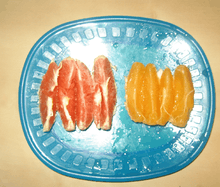Cara cara navel
| Cara cara navel orange | |
|---|---|
 | |
| Species | Citrus × sinensis |
| Cultivar | 'Cara Cara' |
| Marketing names | Power Orange |
| Origin | Hacienda de Cara Cara |
The Cara cara navel, or red-fleshed navel orange is an early-to-midseason navel orange believed to have developed as a cross between the Washington navel and the Brazilian Bahia navel.[1]
Discovered at the Hacienda de Cara Cara[2] in Valencia, Venezuela in 1976,[3] the parentage is apparently uncertain enough to occasionally warrant the distinction of a mutation, with only the tree on which it was found—the Washington navel—being an accepted progenitor. Cara caras did not enter the U.S consumer produce market until the late 1980s[4] and were carried only by specialty markets for many years thereafter.
Characteristics

This medium sized navel is sweet and low in acid. The flavor is more complex than most navel varieties and has been described as evoking notes of cherry, rose petal, orange, and blackberry.[5]
Season
From the major growing regions, South African Cara caras are ready for market starting in August, Venezuelan fruits arrive in October and Californian fruits make their seasonal debut in late November and are available through April.
References
- ↑ Susser, Allen (1997). The Great Citrus Book: A Guide with Recipes. Ten Speed Press. ISBN 978-0-89815-855-7.
- ↑ 10°14′41″N 67°56′52″W / 10.2447°N 67.9478°W from here
- ↑ "Cara Cara navel orange". Citrus Variety Collection. University of California Riverside. Retrieved January 30, 2012.
- ↑ Kauffman, Jonathan (December 26, 2006). "Cara cara mia". Seattle Weekly's Voracious Blog. Archived from the original on 2012-05-15.
- ↑ Mosquin, Daniel. "Citrus sinensis 'Cara Cara'". Botany Photo of the Day. University of British Columbia Botanical Garden and Centre for Plant Research. Retrieved January 30, 2012.